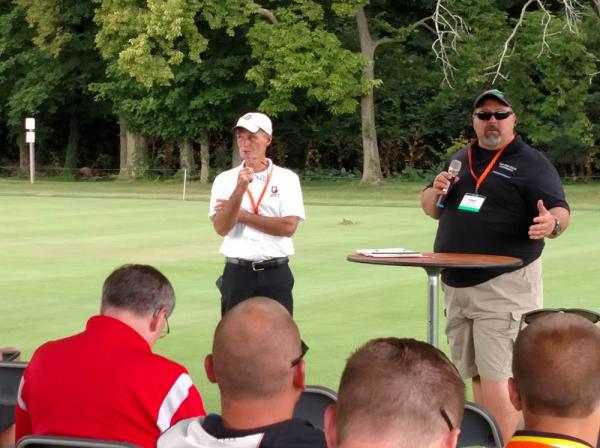As a turfgrass researcher, Todd Hicks used to be wary of growing conditions in August. Any more? Not so much.
 "In the old days, I don't feel like I'm that old, but evidently I am, I used to fear August," said Hicks, research program manager for the turf pathology department at Ohio State at this year's Ohio Turfgrass Foundation Turf Research Field Day. "It was a heavy month, then in September it started to slow down, and in October you looked forward to shutting her down."
"In the old days, I don't feel like I'm that old, but evidently I am, I used to fear August," said Hicks, research program manager for the turf pathology department at Ohio State at this year's Ohio Turfgrass Foundation Turf Research Field Day. "It was a heavy month, then in September it started to slow down, and in October you looked forward to shutting her down."That hasn't been the case in late summer and early fall in Ohio the past few years, however, as mild conditions have persisted deeper into the calendar.
For example, temperatures in September 2016 reached 90 degrees on five occasions in Columbus. On seven days throughout the month, six of which fell after the 17th, the daily high exceeded the historic average by 10 degrees or more. That trend continued in October, with temperatures of 80 degrees or more on eight days, and on 10 occasions the daily high beat the average by at least 10 degrees.
"In years like this, we have one month, December, where we have cool conditions," Hicks said. "This year, guys were mowing in Ohio by the end of January. The turf got one month off. Diseases and other problems were doing the same thing. You end the season behind, and start the next season with shorter roots."
That trend is not unique to central Ohio or the OTF Turfgrass Research and Education Facility. It's one that is occurring with regularity in many locales around the country. And it is beginning to change the way some researchers look at turf management.
"We're now transitioning to a longer, warmer fall. More than 50 percent of the golf courses I talk to are busier in September than they are in August," Hicks said.
"Traditionally, people have been taking their foot off the gas a bit by then. Guys are tired and they're losing some of their help. But now, you still have a lot of things going on, and it's easy to fall behind. Then you add on things like normal agronomic practices, which are set on the schedule because of time and play. We have to stop and look at what we're doing. We are doing everything agronomically wrong because of the golfer."
Hicks says agronomic practices should be scheduled around local weather conditions, not golfers. And changing some of those practices, like solid tining rather than coring, can make that easier.
"Breaking up the soil and letting some air in there is a good thing. The only time you need to think about pulling a core is when you have thatch issues," Hicks said.
"Superintendents are doing more than they've ever done, and sometimes I think they just don't have time to ask these questions."
If we'd gotten two solid weeks of heat and humidity this summer, we'd have to change our phone numbers."
Because of changes in the local climate the past couple of years, Hicks and Joe Rimelspach, Ph.D., turf pathologist at Ohio State, are seeing some things in the field they aren't always used to seeing, including gray leaf spot in juvenile tall fescue and gray leaf spot on perennial ryegrass. Throw on top of that typical hot and humid summer conditions, and some old favorites are back stronger than ever.
"I've never seen dollar spot this aggressive or severe in high-cut turf than it is this year," Rimelspach said. "I don't know what it is, but in Ohio this is the worst year I've seen.
"Last year, we saw gray leaf spot in perennial ryegrass first on July 29. This year, the first reported sighting was at least two weeks earlier than that.
"This has been a challenging year."
The only thing bailing out superintendents this summer, Hicks said, has been a seemingly regular cycle this summer of a few hot, humid days followed by a couple of days of cooler temperatures. If it weren't for that, he said, the phone in the OSU turf pathology lab would be ringing much more often than it already is.
"The saving grace has been that feast-or-famine weather pattern of three to five days of hot followed by two to three days of cooler temperatures that allow guys to catch up," Hicks said. "If we'd gotten two solid weeks of heat and humidity this summer, we'd have to change our phone numbers."

